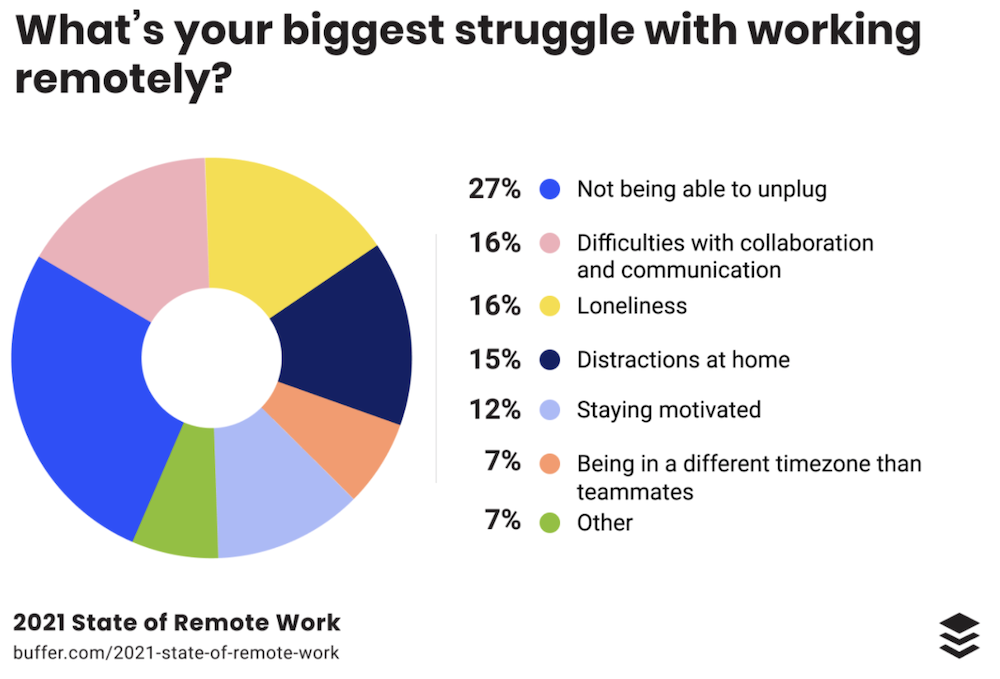Many companies are adapting to the changing work culture allowing their employees to do much, or all, of their job remotely. But there are challenges of working from home that are undeniable.
These changes present new challenges for both employers and workers including how productivity is ensured without face-to-face contact.
For most people, the thought of working from home is very exciting. After all, there are pros and cons of working remotely and it’s, overall, pleasant.

The idea behind working from home is a great one- you can save money on gas and your commute time by leaving work late every day.
This article focuses on understanding what these various workplace concerns are from a business perspective in order to better address them.
In this guide, we’ll go through the biggest challenges of working from home for both employees and employers. From isolation to decreased productivity and more, make sure to read till the end to be happier.
Communication Issues Are Real
One of the biggest challenges of working from home is social isolation, and it’s real.
It is crucial for employers and workers alike, especially in the office-based environment, to maintain a social presence. It’s not all about productivity; it has been proven that interacting with other people on a daily basis boosts mental health.
The State of Remote 2021 by Buffer revealed that the second biggest struggle for employees working from home is communication. In fact, 16% of employees have difficulties communicating and collaborating with colleagues from home.

It is certainly something both employees and management should take into consideration when designing work schedules or implementing new policies.
How To Solve Communication Challenges on a Remote Team?
While it’s one of the biggest challenges of working from home, there are a few methods to end communication issues.
The key to limiting the negative impact of ever-present technology is creating a company culture where employees use online communication tools often.
Creating channels that allow social sharing can encourage staff members to discuss personal topics like weekend plans or even just their kids.
For example, Microsoft Teams, Slack, and Zoom provide something akin to typical work-based social interaction.
These eventually reduce collaboration issues for both business and personal conversations.
Productivity Levels May Drop
Although endless studies show that remote employees tend to be highly productive, this will not always hold true for every single one of them.
For employers, the key challenge centers around making sure their workers maintain a similar level of productivity they would have in an office setting.

With no direct supervision going on, it’s easy for productivity levels to be one of the challenges of working from home.
There are many benefits to remote work, including an increased sense of autonomy and more variety in the types of tasks that can be done.
However, there is also a potential drawback: some individuals may not feel as if their productivity matches what it would have been had they remained onsite.
Employers should take these factors into consideration when determining whether working remotely will benefit the company overall.
How To Improve Productivity When Working From Home?
Remote workers will be more productive if they are regularly contacted by their employer and when there is a clear target for them to work towards.
When the remote worker isn’t working hard enough, employers can use performance monitoring software. While this isn’t ideal, it will help identify where employees need further guidance in order to keep up productivity levels.
Physical Discomfort When Working From Home
For many office workers, ergonomics are essential to a quality work experience. This is because it limits issues related to physical discomfort. This can eventually lead to employees’ lower productivity and higher absenteeism rate.
However, remote employees not having access to good equipment like desks or chairs on-site might cause dissatisfaction that could result in long-term effects. For example, increased pain from bad posture while working remotely.
While working online gives you the chance to get things done anywhere, Buffer found out that 80% of employees primarily work from home.
So, how to be more comfortable when working from home?
When purchasing furniture for your workstation – especially desks and chairs – you need to think about what materials will be best suited.
For instance, many organizations help employees pay for an ergonomic chair and desk when transitioning to a work-from-home setting.
Cyber Security Issues Coming From Remote Work
Remote access work can open up your organization to cyber-risks because the added security measures will vary from your office setting.
The risks are so great that it is important you take preventative steps now before something happens – whether intentional or unintentional.
The best way to prevent cybersecurity issues is to get connected to a VPN. I’ve personally been using NordVPN for the past 2 years and it protects me and my data.
It’s easy to use, you can use it to stay safe online, to watch movies on American Netflix when in other countries, and even to keep your information safe from governments.

Most of the time, it is best just to invest in dedicated work computers and a VPN rather than risking your business failing.
To conclude, cybersecurity is a real issue and definitely a big challenge of working from home for both employees and employers.
Remote Workers Get More Sedentary
Remote work is a growing trend in the modern world. But, if you’re not taking breaks every so often and work out, there’s an increased risk of health problems.
Getting rid of your commute can also make it harder for people who do remote work to fit exercise into their day or even walk outside. They might have more trouble exercising on top of everything else that needs to be done.
How To Stop Being Sedentary Working From Home?
The importance of taking scheduled breaks is not a secret. There are many reasons for these, but the most important one should be that this gives employees time to re-energize and walk.
Organizations can help by setting up team meetings where they discuss ways to incorporate exercise into workday life or providing sit-stand desks.
This way, workers have options when it comes down to sitting vs standing during an 8 hour day at work.
Also, waking up earlier allows employees to work out before their shift making their life healthier.
Last but not least, eating healthy food such as fruits, vegetables, and avoiding snacks throughout the day is also essential.
Issues Around Work/Life Balance
Work/life balance is among the biggest challenges of working remotely and can have consequences for employers.
While work/life balance usually gets better for remote employees, Buffer reveals that 18% of workers find it hard to unplug after work.
Apart from that, according to an analysis by Forbes, 26% of work done when working remotely is out of schedule.
Spending too much time working will eventually impact their quality of life and that is certainly something to consider when transitioning to WFH.
How To Increase Work/Life Balance When Working Remotely?
First of all, you should know your mental and physical limits. Create an appropriate workstation that doesn’t invade your personal space in your home.
Also, taking breaks is essential not only for productivity but also for increasing your overall health and work/life balance.
Last but not least, be transparent with your employer and share your struggles on top of the happy moments. You’ll find that they can be understanding and they may adapt your schedule based on your needs.
Not Willing To Work From Home
One issue that can arise is the reluctance of some employees to work remotely from home. In fact, some of them may be distracted at home or they might not have adjusted well after being in a long-term habit of going to the office.
Simply ignoring this problem will lead people to become unhappy and they may even quit looking for jobs elsewhere
Employee’s unwillingness to work remotely is one concern managers face when providing flexible schedules. However, it doesn’t necessarily mean you should stop trying because there are plenty more benefits than drawbacks if managed properly.
According to the employees surveyed by Buffer, only 3% wouldn’t recommend working from home to their friends or family.
That is to say, working remotely is great with endless benefits. However, some individuals may find it to be a challenge.
Our Take On The Pros And Cons Of Working Remotely
Remote work has numerous benefits over traditional office jobs. However, as a remote worker, you will need to be able to communicate effectively with the team and remain productive no matter what.
Employers should also set up an environment where employees can adopt some flexibility for working arrangements when possible.
In conclusion, managers of remote teams and their members face a number of challenges, but many are actually solvable rather easily.







